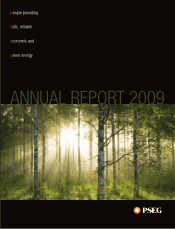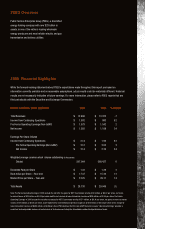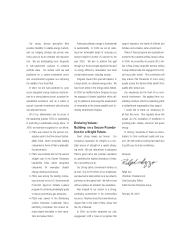PSE&G 2009 Annual Report Download - page 4
Download and view the complete annual report
Please find page 4 of the 2009 PSE&G annual report below. You can navigate through the pages in the report by either clicking on the pages listed below, or by using the keyword search tool below to find specific information within the annual report. We never lightly approach the need for a
rate increase, yet reliability must be maintained
in all economic climates. In May 2009, in
order to assure our continued ability to meet
essential service obligations, PSE&G fi led with
the New Jersey Board of Public Utilities for an
increase in electric and gas base rates. Even
with this necessary increase, PSE&G’s rates
would remain lower than average among
utilities in its region while delivering best-in-
class service.
Maintaining reliability requires not only
strong local distribution networks, but an
adequate system of high power transmission
lines. In February 2010, PSE&G received
approval from the New Jersey Board of Public
Utilities to construct the Susquehanna-to-
Roseland (S-R) transmission line. This was
a major milestone in the ongoing regulatory
approval process for the project, which is
required to prevent possible brownouts and
blackouts. Due to this backbone reliability
role, the S-R line has received federal approval
for incentive rates.
PSE&G has long demonstrated the power
of a utility to provide universal access to
safe, reliable and economic energy. In 2009,
PSE&G showed that utilities can be equally
instrumental in efforts that expand access
to green energy and boost the economy. In
doing so, we are helping to brighten New
Jersey’s future while supporting some of
society’s most important objectives – for
clean air, good jobs and healthier, sustain-
able communities.
Refl ecting these objectives, PSE&G re-
ceived regulatory approval in 2009 for
nearly $1.5 billion in green and accelerated
infrastructure investments that allow for con-
temporaneous returns for our shareholders.
These activities fall in three main areas:
• Energy Effi ciency: PSE&G is moving
ahead with approximately $200 million
in conservation and carbon-abatement
programs to help our customers save
energy and dollars. This effort is
improving access to energy effi ciency
for a broad range of customers, including
low-income urban residents, small
businesses, hospitals and municipalities.
• Solar Energy: PSE&G has more than
$600 million in initiatives supporting
solar energy development in New
Jersey. In December 2009, PSE&G
received regulatory approval to
expand its initial 30-megawatt solar
loan program by approximately $140
million to fi nance the installation of an
additional 50 megawatts of solar energy
systems on homes, businesses and
municipal buildings. In addition, PSE&G
is investing directly in solar through the
$515 million Solar 4 All program to
bring 80 megawatts of grid-connected
solar energy to all our customers and
create more green jobs as well. This
involves installing solar units on up to
200,000 utility poles and street lights
in about 300 New Jersey communities
– the world’s largest effort of this type.
Also, PSE&G has begun to develop solar
gardens and roof-top installations at its
own facilities and third-party sites.
•
Accelerated Infrastructure Projects:
PSE&G is investing $694 million in
accelerated system upgrades to provide
a stimulus for New Jersey’s economy
while also improving reliability. This
effort is underway and is expected to
generate some 900 new jobs.
PSEG Power:
Managing a Strong, Diverse
Generation Portfolio
PSEG Power, our largest source of earnings,
has approximately 15,500 megawatts of
generating capacity and operates one of
the most balanced portfolios among major
U.S. power producers. PSEG Power’s assets
are located in attractive markets near load
centers – mostly in the Northeastern U.S.,
but including 2,000 megawatts of capacity
in Texas.
We actively manage our generation
portfolio to take advantage of the fl exibility
we enjoy with base load, load-following and
peaking units running on a variety of fuels
and technologies – including nuclear, coal
and natural gas. The breadth of our portfolio
enables us to better respond to changes in
fuel prices.
Risk management anchors our participa-
tion in energy markets. Our long-standing
practice is to hedge a substantial part of our
anticipated energy output on a rolling basis.
We generally do this through mechanisms
such as New Jersey’s Basic Generation Ser-
vice (BGS) auction, in which only a portion of
the load is bid each year to help smooth out
prices for suppliers and consumers alike.
Portfolio management ultimately depends
on superb fl eet operations – and PSEG
Power has increasingly achieved operations
characterized by excellence. In 2009,
PSEG Power’s nuclear and combined cycle
fl eets experienced record levels of output.
Our nuclear generating facilities again had
outstanding accomplishments such as Salem
Unit 2’s longest continuous run of 515 days
between refueling outages. Our nuclear units
combined to produce more than 50 percent










